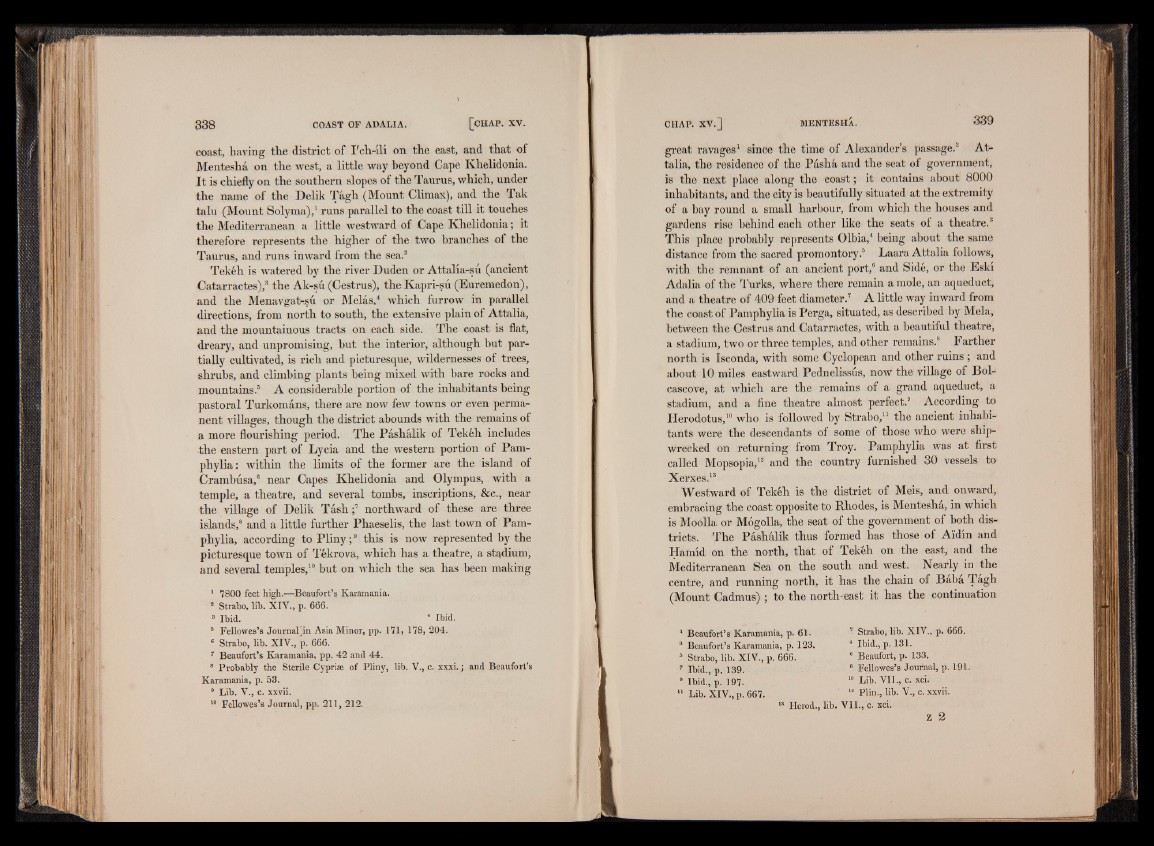
coast, having the district of I'ch-ili on the east, and that of
Mentesha on the west, a little way beyond Cape Khelidonia.
It is chiefly on the southern slopes of the Taurus, which, under
the name of the Delik Tagh (Mount Climax), and the Tak
talu (Mount Solyma),1 runs parallel to the coast till it touches
the Mediterranean a little westward of Cape Khelidonia; it
therefore represents the higher of the two branches of the
Taurus, and runs inward from the sea.®
Tekeh is watered by the river Duden or Attalia-su (ancient
Catarractes),3 the Ak-su (Cestrus), the Kapri-su (Euremedon),
and the Menavgat-su or Melas,4 which furrow in parallel
directions, from north to south, the extensive plain of Attalia,
and the mountainous tracts on each side. The coast is flat,
dreary, and unpromising, but the interior, although but partially
cultivated, is rich and picturesque, wildernesses of trees,
shrubs, and climbing plants being mixed with bare rocks and
mountains.6 A considerable portion of the inhabitants being
pastoral Turkomans, there are now few towns or even permanent
villages, though the district abounds with the remains of
a more flourishing period. The Pashalik of Tek6h includes
the eastern part of Lycia and the western portion of Pam-
phylia: within the limits of the former are the island of
Crambusa,6 near Capes Khelidonia and Olympus, with a
temple, a theatre, and several tombs, inscriptions, &c., near
the village of Delik Tash ;7 northward of these are three
islands,8 and a little further Phaeselis, the last town of Pam-
phylia, according to Pliny;9 this is now represented by the
picturesque town of Tekrova, which has a theatre, a stadium,
and several temples,10 but on which the sea has been making
1 *2800 feet high.—Beaufort’s Karamania.
9 Strabo, lib. XIV., p. 666.
9 Ibid. 4 Ibid.
5 Fellowes’s Journal'in Asia Minor, pp. I l l , 178, 204.
8 Strabo, lib. XIV., p. 666.
7 Beaufort’s Karamania, pp. 42 and 44.
8 Probably the Sterile Cypriae of Pliny, lib. V., c. xxxi.; and Beaufort’s
Karamania, p. 53.
9 Lib. V., c. xxvii.
10 Fellowes’s Journal, pp. 211, 212.
great ravages1 since the time of Alexander’s passage.2 Attalia,
the residence of the Pasha and the seat of government,
is the next place along the coast; it contains about 8000
inhabitants, and the city is beautifully situated at the extremity
of a bay round a small harbour, from which the houses and
gardens rise behind each other like the seats of a theatre.3
This place probably represents Olbia,4 being about the same
distance from the sacred promontory.6 Laara Attalia follows,
with the remnant of an ancient port,6 and Side, or the Eskx
Adalia of the Turks, where there remain a mole, an aqueduct,
and a theatre of 409 feet diameter.7 A little way inward from
the coast of Pamphylia is Perga, situated, as described by Mela,
between the Cestrus and Catarractes, with a beautiful theatre,
a stadium, two or three temples, and other remains.8 Farther
north is Isconda, with some Cyclopean and other ruins ; and
about 10 miles eastward Pednelissus, now the village of Bol-
cascove, at which are the remains of a grand aqueduct, a
stadium, and a fine theatre almost perfect.9 According to
Herodotus,10 who is followed by Strabo,11 the ancient inhabitants
were the descendants of some of those who were shipwrecked
on returning from Troy. Pamphylia was at first
called Mopsopia,12 and the country furnished 30 vessels to
Xerxes.13
Westward of Tek6h is the district of Meis, and onward,
embracing the coast opposite to Rhodes, is Mentesha, in which
is Moolla or Mogolla, the seat of the government of both districts.
The Pashalik thus formed has those of Aidin and
Hamid on the north, that of Tekeh on the east, and the
Mediterranean Sea on the south and west. Nearly in the
centre, and running north, it has the chain of Baba Tagh
(Mount Cadmus) ; to the north-east it has the continuation
I Beaufort’s Karamania, p. 61.
8 Beaufort’s Karamania, p. 123.
6 Strabo, lib. XIV., p. 666.
7 Ibid., p. 139.
9 Ibid., p. 197.
II Lib. XIV., p. 667.
18 Herod.,
5 Strabo, lib. XIV., p. 666.
4 Ibid., p, 131.
8 Beaufort, p. 133.
8 Fellowes’s Journal, p. 191.
10 Lib. VII., c. xci.
19 Plin., lib. V., c. xxvii.
V II., c. xci.
z 2